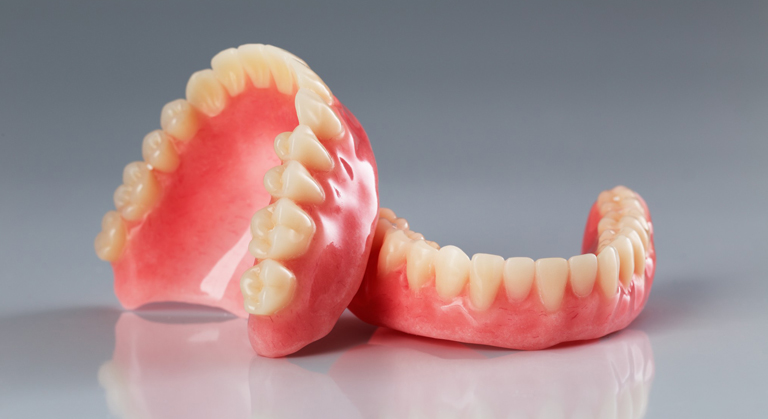Complete Denture

Dentures, also known as false teeth, are prosthetic devices constructed to replace missing teeth; they are supported by the surrounding soft and hard tissues of the oral cavity. Conventional dentures are removable (removable partial denture or complete denture).
Implant supported dentures are restorations that replace missing teeth similarly to a complete denture but are stabilized and held in place by dental implants. A dental implant is an artificial tooth root replacement. The most widely accepted and successful implant today is the osseointegrated implant, based on the discovery by the Swedish Professor Per-Ingvar Branemark that titanium can be successfully fused into bone when osseo blasts (cells that make bone) grow on and into the rough surface of the implanted titanium. This forms a structural and functional connection between the living bone and the implant. Replacement of missing teeth using dental implants has been researched and demonstrated to be clinically successful for more than 30 years in Sweden and was introduced into North America at the Toronto Conference in 1982. Historically, dental implants have a high clinical success rate.
Dental implants can usually be placed in either jaw. Although many patients have no problem wearing an upper denture, some find it difficult to wear lower dentures. For that reason, dental implants are most frequently placed in the lower jaw. Depending on the number of implants that are placed, different restorative options are possible.
The first option is to have two implants placed in the front of the lower jaw and a denture (implant overdenture) made that snaps onto these implants. The implant overdenture is partly supported by the implants and partly supported by the gums. There will still be some movement of lower denture but stability and comfort will be improved.
A second option involves placing four to six implants. After healing is complete, the implants are connected with a custom made support bar. The denture will be made with special retention clips inside that attach onto the support bar , allowing the denture to snap firmly into place. The advantage of this option is that it is much more stable than the first option, allowing very little denture movement. The implants will completely support the denture and because of this, the denture will not move thus will not cause sore spots. The denture still will be removable for easy cleaning and maintenance.
The successes in the areas of implant supported single tooth or full mouth restorations have led to the consideration of obtaining implant support for the removable partial denture. Implants can make a major contribution to the success of a removable partial denture when are used in conjunction with thorough mouth preparation of soft (gums) and hard (teeth and bone) tissues, employ precisely fitting castings, and are cared for with regular recall and appropriate maintenance. Similarly to a conventional partial denture, some natural teeth will be selected to help support and hold the partial denture in place. One or more implants would be used in place of missing natural teeth providing critical support for partial denture through the use of a number of attachment systems. In addition to improved retention , dentures fabricated in conjunction with the implants will dramatically improve the overall appearance, since attachments, unlike conventional clasps are hidden from view and are not visible.